Influence of High-Voltage Corona Discharge on Drying Kinetics and Physicochemical Properties of Alfalfa at Various Air-Gap Spacings
Abstract
:1. Introduction
2. Materials and Methods
2.1. Experimental Materials
2.2. Instruments and Equipment
2.3. Empirical Method
2.4. Determination of Ion Wind Rate in High-Voltage Electric Field
2.5. Voltage and Current Measurement
2.6. Alfalfa Moisture Content Determination
2.7. Rehydration Rate
2.8. Alfalfa Color Difference Measurement
2.9. Determination of Nutrient Composition of Alfalfa
2.10. Study on Infrared Spectrum
2.11. Scanning Electron Microscopy (SEM)
2.12. Measurement of Specific Energy Consumption per Drying Unit of High-Voltage Electric Field
2.13. Statistical Analysis
3. Results
3.1. Drying Characteristics
3.1.1. Analysis of Ion Wind Velocity Measurement Results
3.1.2. Waveforms of Voltage and Current
3.1.3. Analysis of Drying Rate and Drying Time
3.2. Quality
3.2.1. Rehydration Rate
3.2.2. Color Analysis
3.3. Nutritional Quality
3.3.1. Lignin Content
3.3.2. Crude Protein Content
3.3.3. NFC/NDF
3.3.4. NDF and ADF Contents
3.3.5. Relative Forage Quality
3.4. Infrared Spectroscopic Analysis
3.5. Secondary Protein Structure
3.6. Microstructure Analysis
3.7. Energy Consumption
4. Conclusions
Author Contributions
Funding
Data Availability Statement
Conflicts of Interest
Abbreviations
| HVCD | high-voltage corona discharge |
| HAD | hot air drying |
| AD | air drying |
| CP | crude protein |
| NFC | non-fiber carbohydrate |
| ADF | acid detergent fiber |
| NDF | neutral detergent fiber |
| RFQ | relative forage quality |
| SEC | specific energy consumption |
References
- Yan, M.; Yang, D.; He, Y.; Ma, Y.; Zhang, X.; Wang, Q.; Gao, J. Alfalfa Responses to Intensive Soil Compaction: Effects on Plant and Root Growth, Phytohormones and Internal Gene Expression. Plants 2024, 13, 953. [Google Scholar] [CrossRef] [PubMed]
- Ma, J.; Huang, W.; Yang, X.; Xu, J.; Zhang, Y.; Wang, Z. “King of the forage”—Alfalfa supplementation improves growth, reproductive performance, health condition and meat quality of pigs. Front. Vet. Sci. 2022, 9, 1025942. [Google Scholar]
- Gao, Z.; Liu, B.; La, S.; Li, D.; Zhu, X.; Sun, H.; Shi, Y. Alfalfa hay substitution for wheat straw improves beef quality via rumen microflora alteration. Heliyon 2023, 9, e20803. [Google Scholar] [CrossRef] [PubMed]
- Ercan, U.; Kabas, O.; Moiceanu, G. Prediction of Leaf Break Resistance of Green and Dry Alfalfa Leaves by Machine Learning Methods. Appl. Sci. 2024, 14, 1638. [Google Scholar] [CrossRef]
- Suwignyo, B.; Mustika, A.; Kustantinah Yusiati, L.M.; Suhartanto, B. Effect of Drying Method on Physical-Chemical Characteristics and Amino Acid Content of Tropical Alfalfa (Medicago sativa L.) Hay for Poultry Feed. Am. J. Anim. Vet. Sci. 2020, 15, 118–122. [Google Scholar] [CrossRef]
- Rout, S.; Srivastav, P.P. Modification of soy protein isolate and pea protein isolate by high voltage dielectric barrier discharge (DBD) atmospheric cold plasma: Comparative study on structural, rheological and techno-functional characteristics. Food Chem. 2024, 447, 138914. [Google Scholar] [CrossRef] [PubMed]
- Hui, Y.; Huang, C.; Liao, Y.; Wang, D.; You, Y.; Bai, X. The Medium-Blocking Discharge Vibration-Uniform Material Plasma Seed Treatment Device Based on EDEM. Agronomy 2023, 13, 2055. [Google Scholar] [CrossRef]
- Eric, M.; Etienne, D. Ionic wind of a needle-to-plate dielectric barrier discharge. J. Elect. 2022, 120, 103768. [Google Scholar]
- Wang, Y.; Guo, Z.; Wang, B.; Liu, J.; Zhang, M. Effect of high-voltage electrostatic field-assisted freeze-thaw pretreatment on the microwave freeze drying process of hawthorn. Drying Technol. 2023, 42, 477–491. [Google Scholar] [CrossRef]
- Karim, N.; Shishir, M.R.I.; Bao, T.; Chen, W. Effect of cold plasma pretreated hot-air drying on the physicochemical characteristics, nutritional values, and antioxidant activity of shiitake mushroom. J. Sci. Food Agric. 2021, 101, 6271–6280. [Google Scholar] [CrossRef]
- Seelarat, W.; Sangwanna, S.; Chaiwon, T.; Panklai, T.; Chaosuan, N.; Bootchanont, A.; Wattanawikkam, C.; Porjai, P.; Khuangsatung, W.; Boonyawan, D. Impact of Pretreatment with Dielectric Barrier Discharge Plasma on the Drying Characteristics and Bioactive Compounds of Jackfruit Slices. J. Sci. Food Agric. 2023, 104, 3654–3664. [Google Scholar] [CrossRef]
- Wang, Y.; Liu, Y.; Zhao, Y.; Sun, Y.; Duan, M.; Wang, H.; Dai, R.; Liu, Y.; Li, X.; Jia, F. Bactericidal efficacy difference between air and nitrogen cold atmospheric plasma on Bacillus cereus: Inactivation mechanism of Gram-positive bacteria at the cellular and molecular level. Food Res. Int. 2023, 173, 113204. [Google Scholar] [CrossRef] [PubMed]
- Zhang, Y.; Lu, Y.; Huang, D.; Zhao, H.; Huang, S.; Zhang, L.; Li, L. Infrared drying characteristics and optimization of ginseng. Case Stud. Therm. Eng. 2024, 57, 104334. [Google Scholar] [CrossRef]
- Shen, Q.; He, Z.; Ding, Y.; Sun, L. Effect of Different Drying Methods on the Quality and Nonvolatile Flavor Components of Oudemansiella raphanipes. Foods 2023, 12, 676. [Google Scholar] [CrossRef] [PubMed]
- Salehi, F.; Inanloodoghouz, M.; Ghazvineh, S. Influence of microwave pretreatment on the total phenolics, antioxidant activity, moisture diffusivity, and rehydration rate of dried sweet cherry. Food Sci. Nutr. 2023, 11, 7870–7876. [Google Scholar] [CrossRef] [PubMed]
- Aksoy, A.; Karasu, S.; Akcicek, A.; Kayacan, S. Effects of Different Drying Methods on Drying Kinetics, Microstructure, Color, and the Rehydration Ratio of Minced Meat. Foods 2019, 8, 216. [Google Scholar] [CrossRef] [PubMed]
- GB 6432-1986; Method for the Determination of Crude Protein in Feedstuffs. National Standard of the People’s Republic of China: Beijing, China, 1986.
- Digman, M.F.; Cherney, J.H.; Cherney, D.J.R. The Relative Performance of a Benchtop Scanning Monochromator and Handheld Fourier Transform Near-Infrared Reflectance Spectrometer in Predicting Forage Nutritive Value. Sensors 2022, 22, 658. [Google Scholar] [CrossRef] [PubMed]
- Naderi, N.; Ghorbani, G.R.; Erfani, H.; Ferraretto, L.F. Feeding Byproduct-Based Concentrates Instead of Human-Edible Feed Ingredients Increases Net Food Production and Improves Performance of High-Producing Holstein Cows. Animals 2022, 12, 2977. [Google Scholar] [CrossRef] [PubMed]
- Liu, X.; Wang, A.; Zhu, L.; Guo, W.; Guo, X.; Zhu, B.; Yang, M. Effect of additive cellulase on fermentation quality of whole-plant corn silage ensiling by a Bacillus inoculant and dynamic microbial community analysis. Front. Microbiol. 2024, 14, 1330538. [Google Scholar] [CrossRef]
- Beyza, C.; Mahmut, K.; Mevlut, A.; Selma, B.B. Assessment of nutritive value, gas and methane production, fermentation of ensiled mixtures of sorghum–cluster bean. J. Appl. Anim. Res. 2023, 51, 123–129. [Google Scholar]
- Fekadu, D. Nutritional Comparison of Feed Resources for Ruminant Animals Feeding in Ethiopia Using Relative Forage Quality. J. Nat. Sci.Res. 2018, 8, 1–7. [Google Scholar]
- Sriariyakul, W.; Swasdisevi, T.; Devahastin, S.; Soponronnarit, S. Drying of aloe vera puree using hot air in combination with far-infrared radiation and high-voltage electric field: Drying kinetics, energy consumption and product quality evaluation. Food Bioprod. Process. 2016, 100, 391–400. [Google Scholar] [CrossRef]
- Rubinetti, D.; Iranshahi, K.; Onwude, D.; Reymond, J.; Rajabi, A.; Xie, L.; Defraeye, T. Ionic wind amplifier for energy-efficient air propulsion: Prototype design, development, and evaluation. Clean. Eng. Technol. 2024, 19, 100728. [Google Scholar] [CrossRef]
- Defoort, E.; Bellanger, R.; Batiot-Dupeyrat, C.; Moreau, E. Ionic wind produced by a DC needle-to-plate corona discharge with a gap of 15 mm. J. Phys. D Appl. Phys. 2020, 53, 175202. [Google Scholar] [CrossRef]
- Feng, J.; Wang, C.; Wu, C.; Liu, Q. Experimental investigation on flow characteristics of ionic wind induced by wire electrode. J. Chin. Inst. Eng. 2021, 44, 22–32. [Google Scholar] [CrossRef]
- Jung, S.; Fang, J.; Chadha, S.T. Atmospheric pressure plasma corona enhanced by photoionizer for degradation of VOCs. J. Phys. D Appl. Phys. 2018, 51, 445206. [Google Scholar] [CrossRef]
- Srivastav, S.; Shah, M.; Ganorkar, P.M.; Kumar, K. Modelling of electrohydrodynamic drying kinetics for carrot at varying electrode distance. J. Food Sci. Technol. 2024, 61, 139–149. [Google Scholar] [CrossRef] [PubMed]
- Sumariyah, S.H.P.; Muhammad, N. Drying of Electrohydrodynamic (Ehd) on Potato Slices (Solanum Tuberosum) with Electrode Distance Variation. J. Nat. Sci. Res. 2019, 9, 21–25. [Google Scholar]
- Fakhreddin, S.; Sara, G.; Moein, I. Effects of edible coatings and ultrasonic pretreatment on the phenolic content, antioxidant potential, drying rate, and rehydration ratio of sweet cherry. Ultrason. Sonochem. 2023, 99, 106565. [Google Scholar]
- Fakhreddin, S.; Kimia, G.; Helia, R.K. Effects of different pretreatment techniques on the color indexes, drying characteristics and rehydration ratio of eggplant slices. Results Eng. 2024, 21, 101690. [Google Scholar]
- Xiao, A.; Ding, C. Effect of Electrohydrodynamic (EHD) on Drying Kinetics and Quality Characteristics of Shiitake Mushroom. Foods 2022, 11, 1303. [Google Scholar] [CrossRef] [PubMed]
- Zhang, S.; Wu, S.; Yu, Q.; Shan, X.; Chen, L.; Deng, Y.; Li, J. The influence of rolling pressure on the changes in non-volatile compounds and sensory quality of congou black tea: The combination of metabolomics, E-tongue, and chromatic differences analyses. Food Chem.-X 2023, 20, 100989. [Google Scholar] [CrossRef] [PubMed]
- Vishal, K.; Shekhar, S.C.; Shiva, B.; Sudhir, K.; Prakash, Y.S.; Kumar, P.V. Physicochemical and bioactive constituents, microbial counts, and color components of spray-dried Syzygium cumini L. pulp powder stored in different packaging materials under two controlled environmental conditions. Front. Nutr. 2023, 10, 1258884. [Google Scholar]
- Zhong, H.; Zhou, J.; Abdelrahman, M.; Xu, H.; Wu, Z.; Cui, L.; Ma, Z.; Yang, L.; Li, X. The Effect of Lignin Composition on Ruminal Fiber Fractions Degradation from Different Roughage Sources in Water Buffalo (Bubalus bubalis). Agriculture 2021, 11, 1015. [Google Scholar] [CrossRef]
- Chen, J.; Yu, T.; Cherney, J.H.; Zhang, Z. Optimal Integration of Optical and SAR Data for Improving Alfalfa Yield and Quality Traits Prediction: New Insights into Satellite-Based Forage Crop Monitoring. Remote Sens. 2024, 16, 734. [Google Scholar] [CrossRef]
- Santana, A.; Cajarville, C.; Mendoza, A.; Repetto, J.L. Including 8 hours of access to alfalfa in 1 or 2 grazing sessions in dairy cows fed a partial mixed ration: Effects on intake, behavior, digestion, and milk production and composition. J. Dairy Sci. 2023, 106, 6060–6079. [Google Scholar] [CrossRef] [PubMed]
- Song, S.D.; Chen, G.J.; Guo, C.H.; Rao, K.Q.; Gao, Y.H.; Peng, Z.L.; Zhu, W.L. Effects of exogenous fibrolytic enzyme supplementation to diets with different NFC/NDF ratios on the growth performance, nutrient digestibility and ruminal fermentation in Chinese domesticated black goats. Anim. Feed Sci. Technol. 2018, 236, 170–177. [Google Scholar] [CrossRef]
- Yanti, G.; Jamarun, N.; Elihasridas; Astuti, T. Quality Improvement of Sugarcane Top as Animal Feed with Biodelignification by Fungi on Digestibility of NDF, ADF, Cellulose and Hemicellulose. J. Phys. Conf. Ser. 2021, 1940, 012063. [Google Scholar]
- Chen, Q.; Cui, Y.F.; Zhang, Z.X.; Jiang, F.C.; Meng, X.Y.; Li, J.J.; Jia, J.L. Effect of alfalfa supplementary change dietary non-fibrous carbohydrate (NFC) to neutral detergent fiber (NDF) ratio on rumen fermentation and microbial function in Gansu alpine fine wool sheep (Ovis aries). Anim. Biotechnol. 2023, 35, 2262539. [Google Scholar] [CrossRef]
- Melo, A.H.F.; Marques, R.S.; Gouvêa, V.N.; Souza, J.; Batalha, C.D.A.; Basto, D.C.; Millen, D.D.; Drouillard, J.S.; Santos, F.A.P. Effects of dietary roughage neutral detergent fiber levels and flint corn processing method on growth performance, carcass characteristics, feeding behavior, and rumen morphometrics of Bos indicus cattle. J. Anim. Sci. 2019, 97, 3562–3577. [Google Scholar] [CrossRef]
- Lu, S.; Xu, Y.; Song, X.; Li, J.; Jiang, J.; Qin, C.; Wu, K.; Cui, K.; Liu, Y.; Liu, Q.; et al. Multi-omics reveal the effects and regulatory mechanism of dietary neutral detergent fiber supplementation on carcass characteristics, amino acid profiles, and meat quality of finishing pigs. Food Chem. 2024, 445, 138765. [Google Scholar] [CrossRef] [PubMed]
- Sartori, A.; Queaque, P.I.; Trocino, A.; Xiccato, G. Increasing dietary starch to ADF ratio in phase feeding programs for early weaned rabbits. Ital. J. Anim. Sci. 2016, 2, 432–434. [Google Scholar]
- Packialakshmi, M.; Palani Divya, M.; Baranidharan, K.; Geetha, S.; Nalliappan Ganesan, K.; Vijayabhama, M.; Manivasakan, S.; Hemalatha, P.; Radha, P.; Tilak, M.; et al. Exploring the Nutritional Potential of Wild Grass Fodder for Mega Herbivore (Elephas maximus) in the Foothills of Western Ghats. Animals 2022, 12, 2668. [Google Scholar] [CrossRef] [PubMed]
- Zhou, M.; Huo, M.; Wang, J.; Shi, T.; Li, F.; Zhou, M.; Wang, J.; Liao, Z. Identification of Tartary Buckwheat Varieties Suitable for Forage via Nutrient Value Analysis at Different Growth Stages. Int. J. Plant Biol. 2022, 13, 31–43. [Google Scholar] [CrossRef]
- Al-Janabi, A.H.A.; Hayati Roodbari, N.; Homayouni Tabrizi, M. Investigating the anticancer and anti-angiogenic effects of graphene oxide nanoparticles containing 6-gingerol modified with chitosan and folate. Cancer Nanotechnol. 2023, 14, 69. [Google Scholar] [CrossRef]
- Stefan, C.; Mateusz, P.; Anna, M. Empirically distinguished anti-aging behaviour of quercetin physically and chemically supported on cellulose carrier: In-situ examination for ethylene-norbornene copolymer. SM&T 2023, 36, e00590. [Google Scholar]
- Saražin, J.; Poljanšek, I.; Pizzi, A.; Šernek, M. Curing Kinetics of Tannin and Lignin Biobased Adhesives Determined by DSC and ABES. J. Renew. Mater. 2022, 10, 2117–2131. [Google Scholar] [CrossRef]
- Garette, S.J.; Edwin, D.R.R.; Shanmugavelayutham, V.S. Characterization of Natural Cellulosic Fiber from Coccinia Grandis Root. J. Nat. Fibers 2022, 19, 9444–9456. [Google Scholar]
- Caglar, A.; Faik, C.; Recai, A. Production of oyster mushroom (Pleurotus ostreatus) from some waste lignocellulosic materials and FTIR characterization of structural changes. Sci. Rep. 2023, 13, 12897. [Google Scholar]
- Ashrafuzzaman, M.; Ahmed, F.; Mimi, A.; Zarin, F.; Shetu, S. Ceramide: An Extravagant Prospective for Treatment of Burn Patients. IFMBE Proc. 2021, 82, 257–271. [Google Scholar]
- Naja, C.; Davide, O.; Federico, C.; Olander, P.H.; Fatemeh, A.; Hailu, F.A. Effect of the extraction process parameters on aquafaba composition and foaming properties. Appl. Food Res. 2023, 3, 100354. [Google Scholar]
- Khamidova, F.Y.; Yormatova, D.Y.; Kh Majidov, K.; Bokijonov, M.M. Features of physico-chemical parameters of local varieties of lentil grains in Uzbekistan. IOP Conf. Ser. Earth Environ. Sci. 2022, 1068, 01023. [Google Scholar] [CrossRef]
- Williams Ashley, E.; Hammer Nathan, I.; Fortenberry Ryan, C.; Reinemann Dana, N. Tracking the Amide I and αCOO− Terminal ν(C=O) Raman Bands in a Family of l-Glutamic Acid-Containing Peptide Fragments: A Raman and DFT Study. Molecules 2021, 26, 4790. [Google Scholar] [CrossRef] [PubMed]
- Dong, X.; Gao, X.; Wang, R.; Liu, C.; Wu, J.; Huang, Q. Evaluation of Polysaccharide Content in Shiitake Culinary-Medicinal Mushroom, Lentinula edodes (Agaricomycetes), via Near-Infrared Spectroscopy Integrated with Deep Learning. Int. J. Med. Mushrooms 2022, 25, 13–28. [Google Scholar] [CrossRef]
- Yang, H.; Li, Y.; Zhao, J.; Chen, Z.; Huang, X.; Fan, G. Regulating the composition and secondary structure of wheat protein through canopy shading to improve dough performance and nutritional index. Food Res. Int. 2023, 17, 113399. [Google Scholar] [CrossRef] [PubMed]
- Krawęcka, A.; Sobota, A.; Zarzycki, P. The Effect of the Addition of Low-Alkaloid Lupine Flour on the Glycemic Index In Vivo and the Physicochemical Properties and Cooking Quality of Durum Wheat Pasta. Foods 2022, 11, 3216. [Google Scholar] [CrossRef] [PubMed]
- Zhang, Y.; Wang, S.; Niu, D.; Huang, Z.; Gai, L.; Hang, F. Effects of moderate dielectric barrier discharge (DBD) plasma treatment on the structure, antigenicity, and digestibility of casein. Food Hydrocoll. 2024, 153, 109973. [Google Scholar] [CrossRef]
- Wang, X.; Han, Z.; Dong, Z.; Zhang, T.; Duan, J.; Ai, L.; Xu, Y. Atmospheric-pressure cold plasma-assisted enzymatic extraction of high-temperature soybean meal proteins and effects on protein structural and functional properties. Innov. Food Sci. Emerg. Technol. 2024, 92, 103586. [Google Scholar] [CrossRef]
- Wen, W.; Li, S.; Wang, J. The Effects of Tea Polyphenol on Chicken Protein Digestion and the Mechanism under Thermal Processing. Foods 2023, 12, 2905. [Google Scholar] [CrossRef]
- Zhu, N.; Yu, N.; Zhu, Y.; Wei, Y.; Zhang, H.; Sun, A.D. Inactivation of Pichia rhodanensis in relation to membrane and intracellular compounds due to microchip pulsed electric field (MPEF) treatment. PLoS ONE 2018, 13, e0198467. [Google Scholar] [CrossRef]
- Brooks, J.R.; Heiman, T.C.; Lorenzen, S.R.; Mungloo, I.; Mirfendereski, S.; Park, J.S.; Yang, R. Transepithelial Electrical Impedance Increase Following Porous Substrate Electroporation Enables Label-Free Delivery. Small 2024. [Google Scholar] [CrossRef] [PubMed]
- VanderBurgh, J.A.; Corso, G.T.; Levy, S.L.; Craighead, H.G. A multiplexed microfluidic continuous-flow electroporation system for efficient cell transfection. Biomed. Microdevices 2024, 26, 10. [Google Scholar] [CrossRef] [PubMed]
- Nyssanbek, M.; Kuzina, N.; Kondrashchenko, V.; Azimov, A. Effects of plasma treatment on biodegradation of natural and synthetic fibers. NPJ Mat. Degrad. 2024, 8, 23. [Google Scholar] [CrossRef]
- Du, Y.; Wang, H.; Yuan, S.; Yu, H.; Xie, Y.; Guo, Y.; Yao, W. Dielectric barrier discharge plasma pretreatment: A cleaner new way to improve energy efficiency and quality of wolfberry drying. J. Clean. Prod. 2024, 450, 141951. [Google Scholar] [CrossRef]
- Wang, L.; Tian, Y.; Wang, K.; Qin, Y.; Chang, Z.; Wang, J. Effects of corona discharge plasma pretreatment on the drying kinetics and quality attributes of lily (Lilium davidii var. unicolor) bulbs. LWT 2024, 200, 116192. [Google Scholar] [CrossRef]
- Alex, M.; Ivanna, B.; Tadeusz, K. The energy efficiency of electrohydrodynamic (EHD) drying of foods. Trends Food Sci. Technol. 2021, 118, 744–764. [Google Scholar]



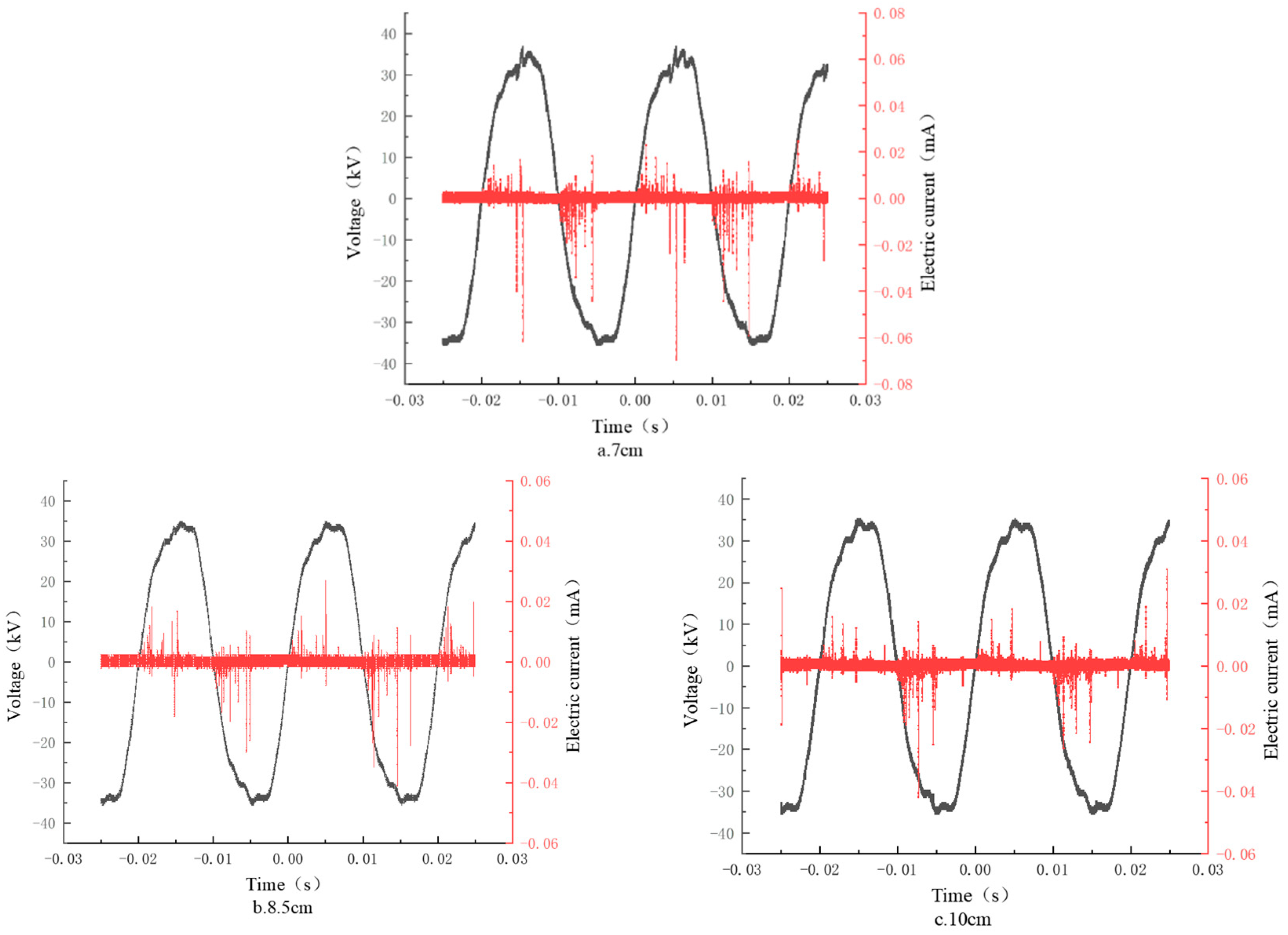
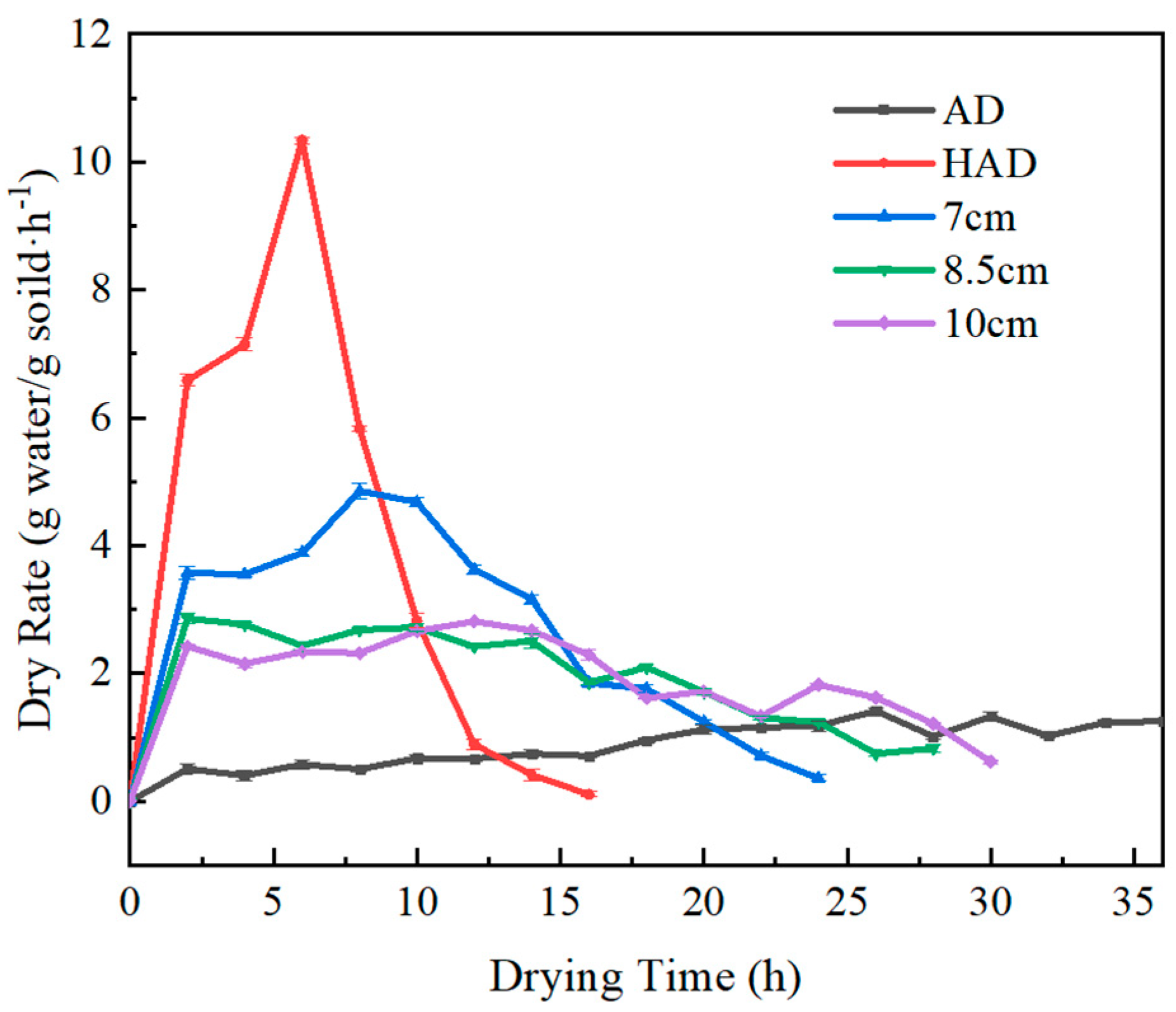




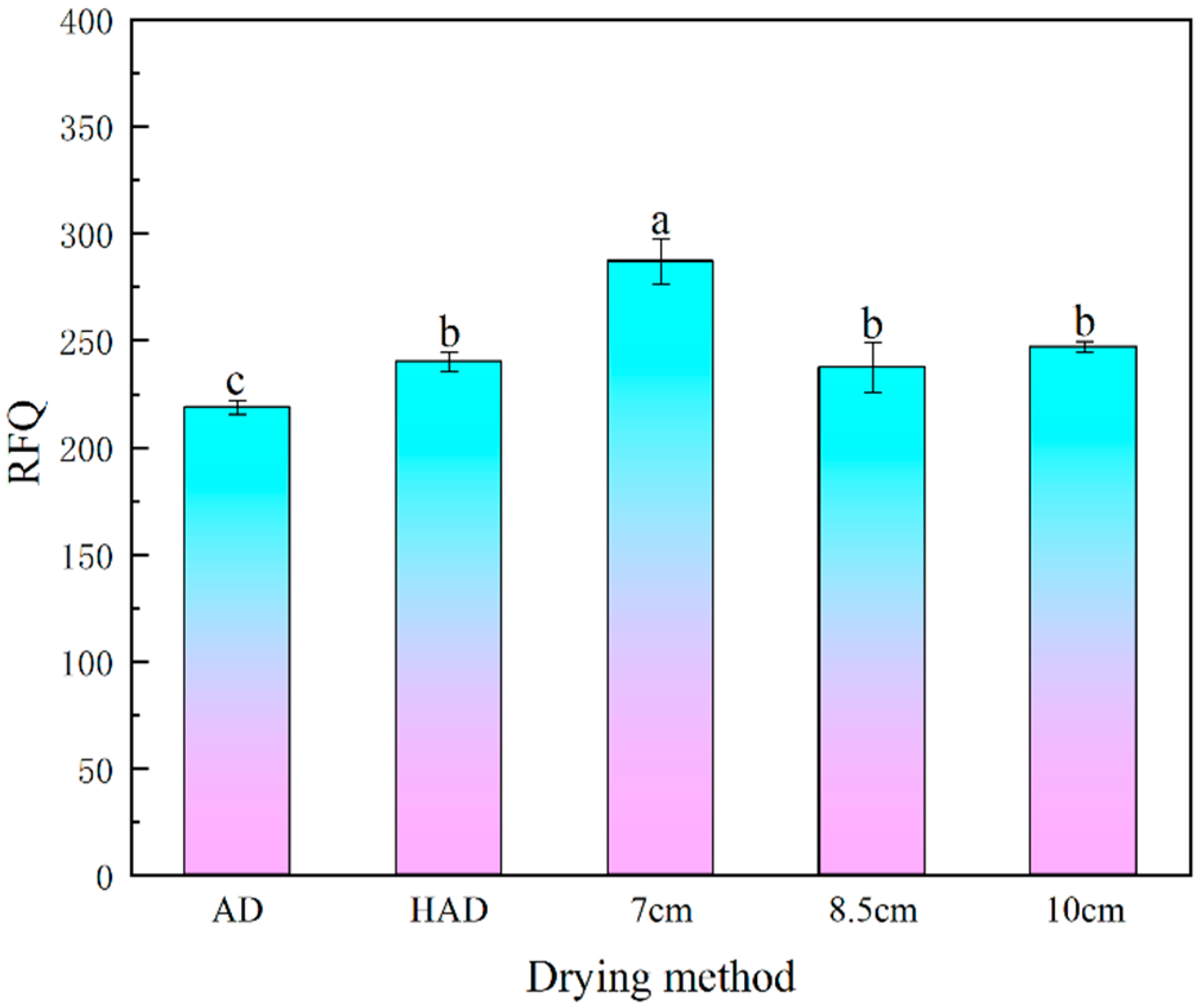
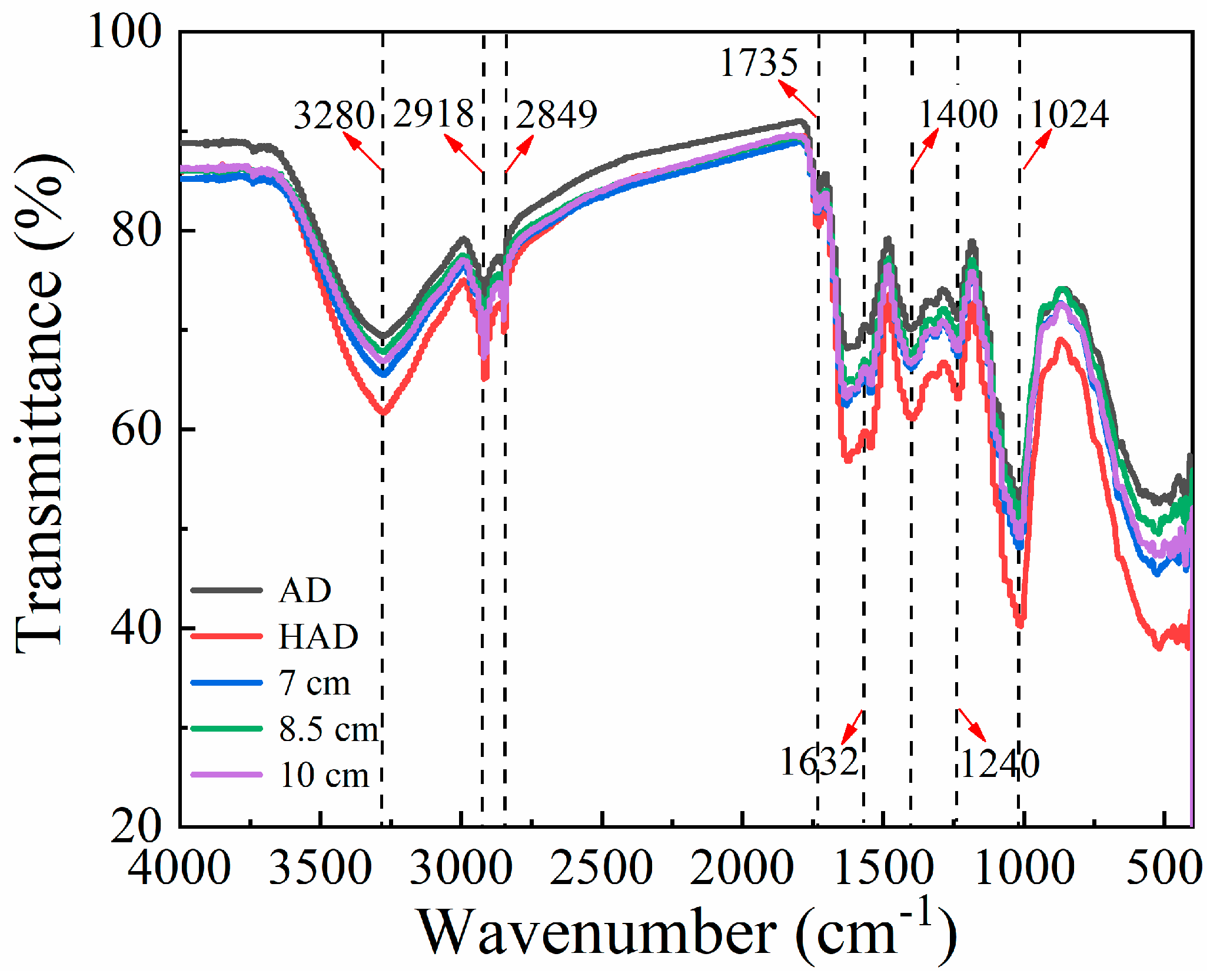
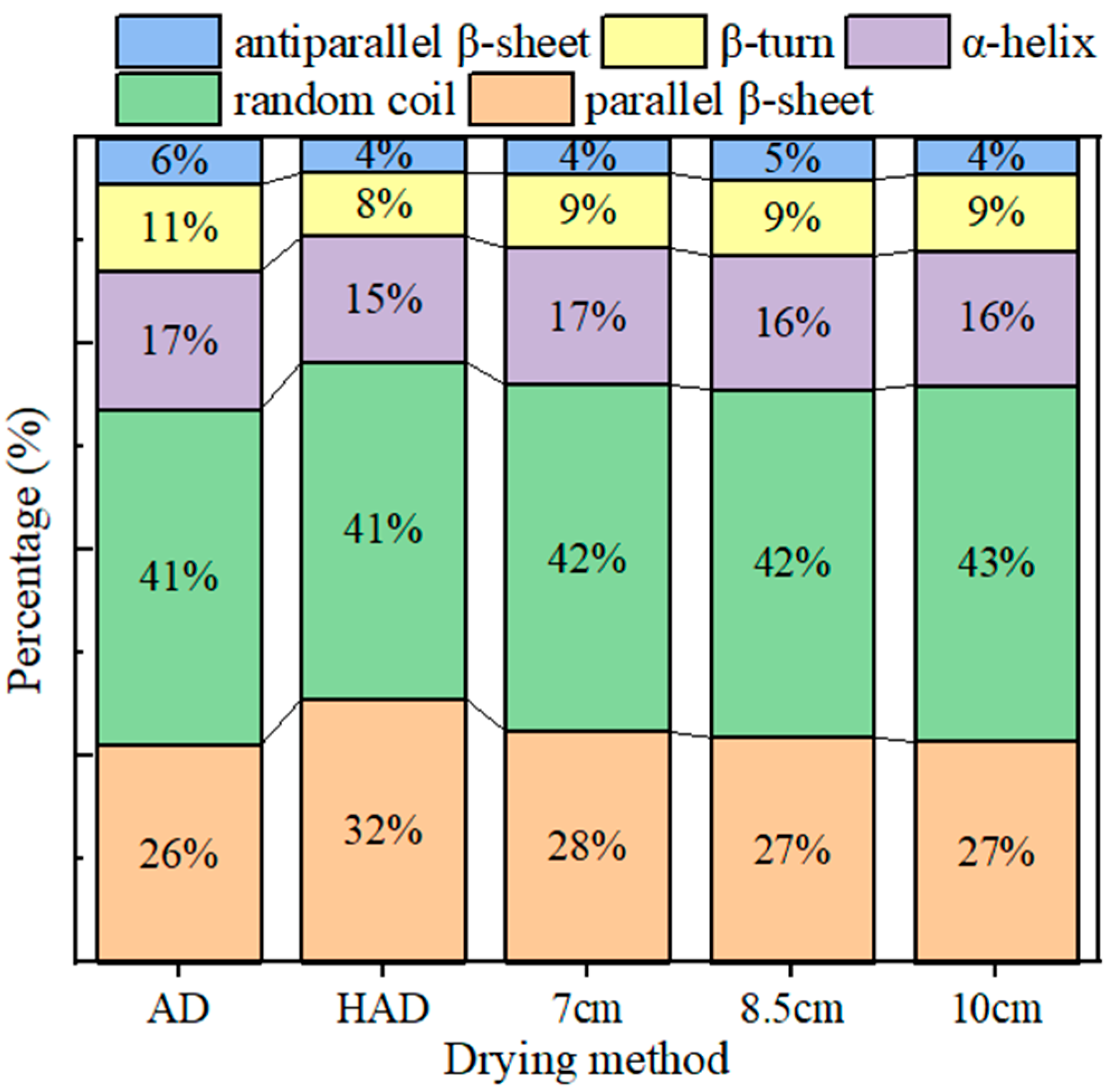
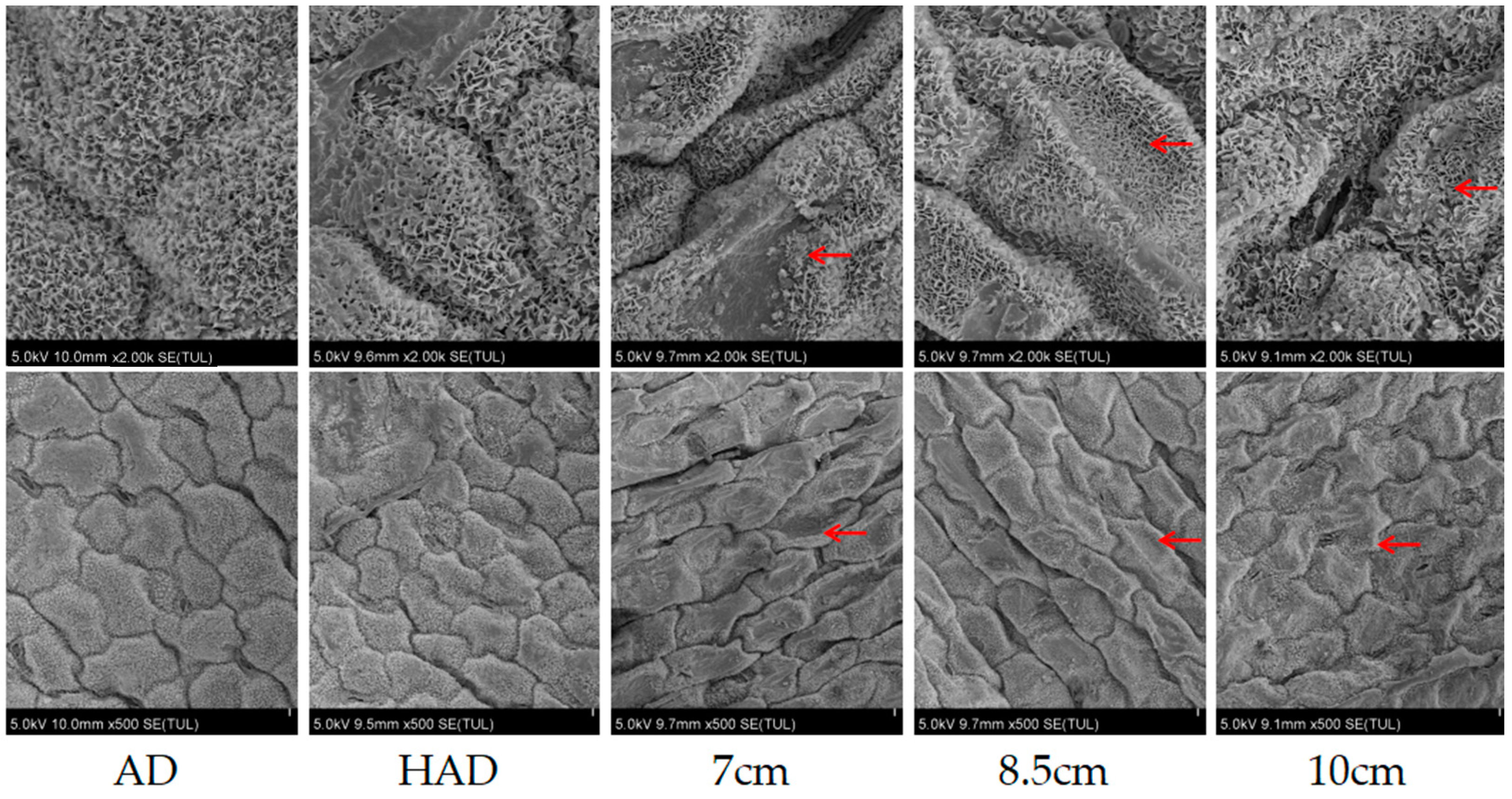
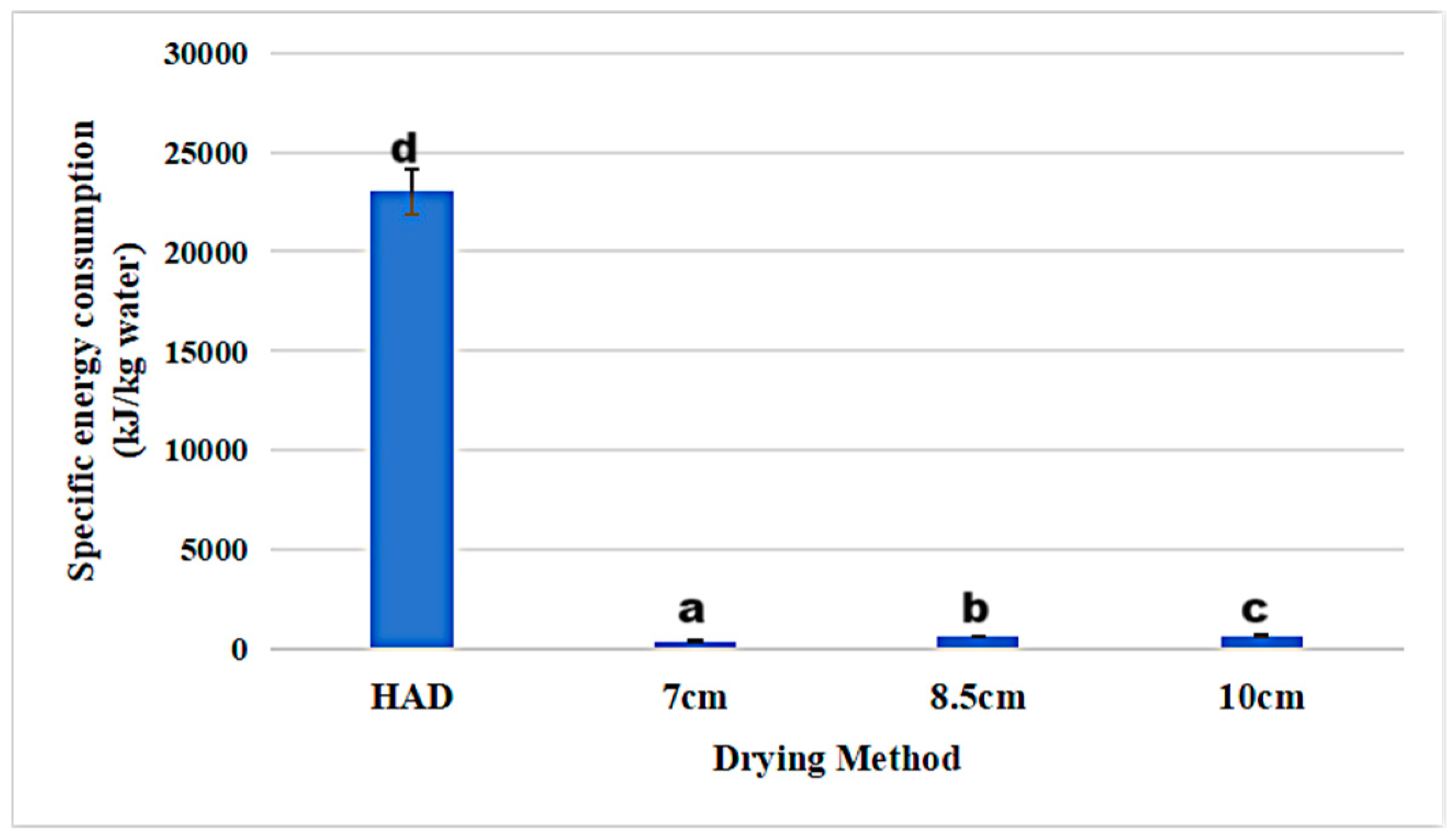
| Drying Method | L* | a* | b* |
|---|---|---|---|
| AD | 43.88 ± 0.93 c | −2.13 ± 1.24 ab | 36.60 ± 0.61 a |
| HAD | 46.81 ± 1.41 b | −9.12 ± 0.46 b | 36.80 ± 0.61 a |
| 7 cm | 48.99 ± 0.93 a | −7.89 ± 0.80 d | 31.24 ± 0.73 d |
| 8.5 cm | 46.97 ± 0.49 b | −5.48 ± 1.02 c | 32.01 ± 1.22 c |
| 10 cm | 47.04 ± 1.20 b | −0.38 ± 0.92 a | 32.55 ± 0.86 b |
| Drying Methods | AD | HAD | 7 cm | 8.5 cm | 10 cm |
|---|---|---|---|---|---|
| NFC/NDF | 1.22 d | 1.29 c | 1.44 a | 1.23 c | 1.31 b |
Disclaimer/Publisher’s Note: The statements, opinions and data contained in all publications are solely those of the individual author(s) and contributor(s) and not of MDPI and/or the editor(s). MDPI and/or the editor(s) disclaim responsibility for any injury to people or property resulting from any ideas, methods, instructions or products referred to in the content. |
© 2024 by the authors. Licensee MDPI, Basel, Switzerland. This article is an open access article distributed under the terms and conditions of the Creative Commons Attribution (CC BY) license (https://creativecommons.org/licenses/by/4.0/).
Share and Cite
Guo, M.; Qian, Y.; Yuan, J.; Song, Z. Influence of High-Voltage Corona Discharge on Drying Kinetics and Physicochemical Properties of Alfalfa at Various Air-Gap Spacings. Agronomy 2024, 14, 1235. https://doi.org/10.3390/agronomy14061235
Guo M, Qian Y, Yuan J, Song Z. Influence of High-Voltage Corona Discharge on Drying Kinetics and Physicochemical Properties of Alfalfa at Various Air-Gap Spacings. Agronomy. 2024; 14(6):1235. https://doi.org/10.3390/agronomy14061235
Chicago/Turabian StyleGuo, Mengheng, Yingying Qian, Jiamin Yuan, and Zhiqing Song. 2024. "Influence of High-Voltage Corona Discharge on Drying Kinetics and Physicochemical Properties of Alfalfa at Various Air-Gap Spacings" Agronomy 14, no. 6: 1235. https://doi.org/10.3390/agronomy14061235





